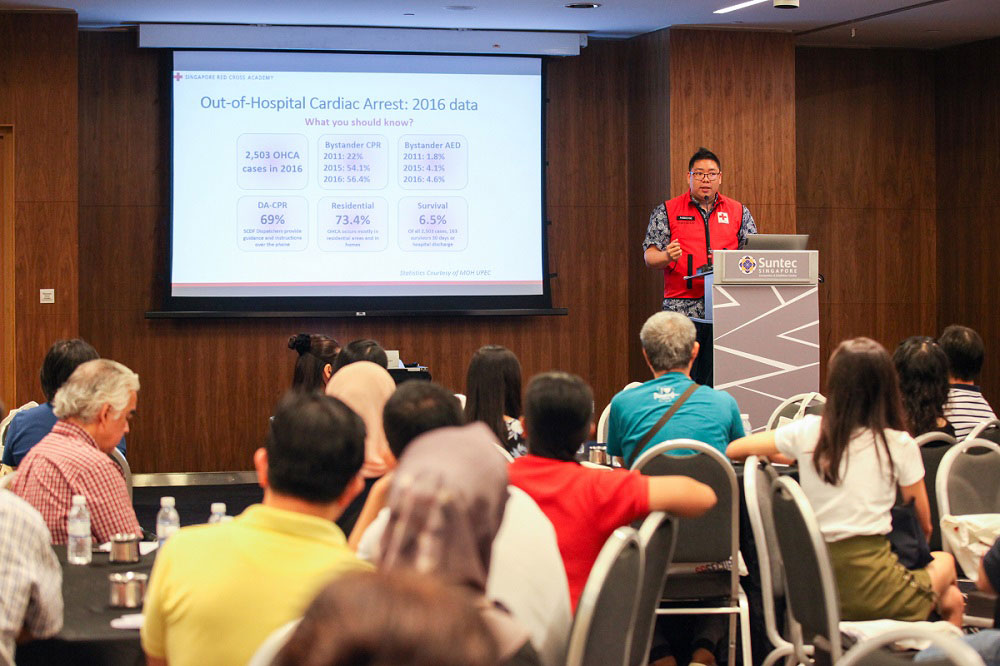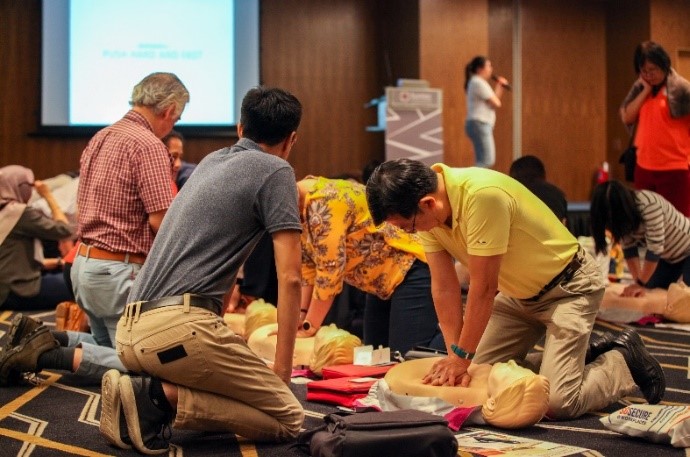Knowing how to identify and tackle common medical emergencies during a crisis is paramount in saving lives. You can be better prepared during such emergencies.
Common medical emergencies at workplaces
Time is of the essence when it comes to medical emergencies.
Learn how to treat common medical emergencies at your workplaces, such as:
- Fainting
- Heat injuries
- Burns
- Bleeding
- Sprains
- Fractures and dislocations
- Stroke
- Fits and seizures
- Cardiac arrest
For stroke cases, it is crucial to identify the F.A.S.T. warning signs to get timely help:
- Facial drooping
- Arms weakness
- Speech difficulties
- Time to call emergency
Emergency action plan
Create an emergency action plan at your workplace to facilitate and organise all members of the organisation in case of a workplace emergency.

The plan should include primary and secondary surveys:
- Primary survey (DRSABC)
- Danger
- Response
- Shout for help
- AED
- Breathing
- Chest compressions
- Secondary survey (SAMPLE)
- Signs and symptoms
- Allergies
- Medications
- Past medical history
- Last meal
- Events leading up to injury
What is DARE programme

The DARE programme is a 1-hour hands-on session where participants learn how to respond to a casualty, while staying on the phone with the medical dispatcher, before the ambulance arrives.
How to respond to a casualty
There are 7 steps to responding to a casualty:
- Check surroundings for any danger.
- Approach casualty.
- Call 995 and let them know your location.
- Stay on the phone with SCDF.
- Observe casualty.
- Start CPR.
- Use the AED.
CPR and AED
Take note that the pads need to be pasted on a bare chest.
There are a few ways to do it:
- Paste it under the shirt.
- For dresses, turtlenecks and tight-fitting clothes, you can slit the side of the clothes where it’s large enough for your hand to enter to paste the pads.
A pair of scissors is included in every AED set.
- You can borrow a jacket from someone nearby to cover up.
If you swapped the top right pad with the bottom left pad, the AED is still able to detect the heart rhythm and function as usual.
If you pasted the pads on the top left and bottom right instead, the AED will not be able to detect anything, and it will constantly remind you to paste the pads.
You will not be faulted for breaking a rib bone. It is common to break a rib bone when administering CPR.
However, take note of the following:
- If you hear a crack when doing CPR, your palms may have shifted. You should reposition your palms in the centre of the chest and start your chest compressions again.
- If you hear a crack for the second time, continue CPR with reduced strength.
- Inform the paramedics about the possibility of a fractured rib bone.
The rule of thumb is to compress one-third of the body depth.
Which AED brand is good and do I need to have one at home?
Show
There is no preferred brand. All brands of AED work equally well.
If there is a member of the household with heart illness, you may get one.
There are also AED sets provided at the void decks of HDB flats.
Yes, you can CPR or use AED, if needed, on a pregnant lady.
In order to save the baby’s life, you need to save the mother’s life first.
More info
Find out more with the following agencies on emergency preparedness:
- Basic emergency preparedness
- Certification courses